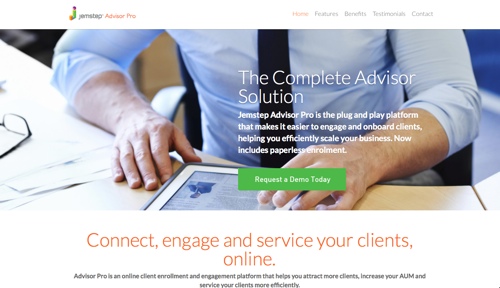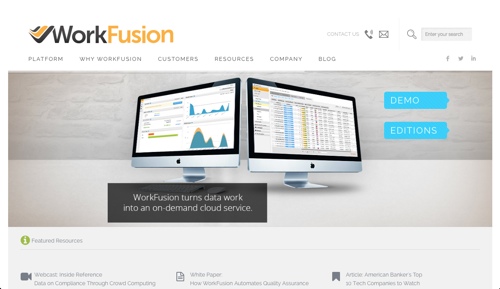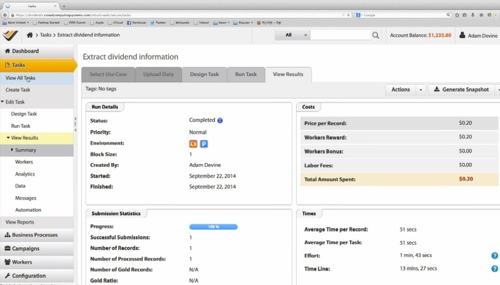
The Finovate Debuts series introduces new Finovate alums. At FinovateFall 2014, WorkFusion launched its active learning automation solution.
WorkFusion
WorkFusion combines machine learning with crowdsourcing to automate data handling. The company’s technology is used by leading financial data vendors and financial services firms for a wide variety of applications including compliance, corporate actions, customer onboarding, loans, and private equity. WorkFusion is a product of CrowdComputing Systems.
The Stats
- Founded in June 2010
- Headquartered in New York, NY
- Raised $23 million in total funding
- Builds and refreshes data products for seven out of the top 10 financial data providers
- Has 68 employees
- Max Yankelevich is CEO and Co-Founder
- Launched WorkFusion’s Active-Learning Automation in September 2014
The Story
WorkFusion began as part of a research project at MIT. The original goal was to combine crowdsourcing and machine learning to detect fraud in online transactions. But as the research progressed, they realized that there was a much bigger opportunity in applying the same combination of automation, crowdsourcing, and “employee experts” to meet broader challenges of enterprise data work.
“We solve a problem around massive data collection and maintenance for financial institutions,” explained WorkFusion CEO Max Yankelevich from the Finovate stage in September. “And we do it for 50% less cost and on a much larger scale.”
The initial edition of WorkFusion launched in 2012 and put the company’s thesis to work automating the process of procuring, training and quality-controlling online workers handling “core enterprise knowledge processes” such as reporting corporate actions and tax accounting information. The solution worked, being both more accurate and less costly compared to a traditional, in-house workforce.
“Giddy disbelief” is how WorkFusion characterized the initial response to their proof of concept, a reaction that encouraged them to scale the project.
The second stage in development was to build algorithms to replicate patterns that were identified as workers completed tasks. One example is pulling stock dividend payout information from a variety of data sources. The first iteration of the platform helped a company marshal human resources from Elance, Amazon Mechanical Turk, and oDesk. The second version uses an algorithm watching for patterns in a given data extraction task, learning which patterns could be automated, and then automating those patterns in the algorithm.
“Each worker is not just getting work done,” Adam Devine, VP Product Marketing said in a Finovate briefing. “They are training our software on how to automate that work.”
WorkFusion refers to this as the “virtual loop.” Human workers perform data-intensive tasks. Algorithms learn how to do the tasks. Human workers are then are available to retrain the algorithms when there are significant changes to the data. This “loop” helps overcome one of the major challenges of automation: adapting to changes in data sets, formats, or flow.
In another example shared with attendees at
FinovateFall last September, a WorkForce customer was able to automate the work that had burdened six FTEs. The cost? Just $54. More importantly, the automation reduced the turnaround time involved from 5 minutes per task to less than 5 seconds.
The technology is workforce-agnostic. That means that the human data analysts involved can be traditional, in-house employees, an outsourced workforce or a crowdsourced one. And the company’s technology makes it the only platform that provides “learning automation” as a service (LAaaS anyone?). There are a platforms that help companies source and/or manage “distributed workforces”, but WorkFusion’s “virtuous loop” keeps human intelligence as a key part of the process, helping set it apart.
The Future
WorkFusion is robust enough to require IT teams to deploy and configure. But the technology is designed to be used by business people rather than technical staff. Typically, clients tend to be larger enterprises. But the solution is “totally scalable”, they say. In one case, a customer is using the technology to start a data science group by himself.
The company’s work has traction: seven out of the top 10 financial information providers currently use it. This spring, WorkFusion announced both a
partnership with uSamp integrating 12 million mobile workers, and a successful, $15 million Series B round led by Mohr Davidow Ventures.
And the company’s work is being noticed. American Banker listed CrowdComputing Systems, provider of WorkFusion, among its
top 10 fintech companies to watch. Barclays ranked WorkFusion in the top 5 of the 36 seven companies invited to participate in its Open Innovation Challenge, and in October, WorkFusion was featured in an article at Inside Market Data touting the platform’s
automation recommendation feature.
Discussing his participation in the
spring investment in WorkFusion, former Thomson Reuters CEO Tom Glocer said earlier this year that the company “very well could be a billion-dollar plus IPO company.” Rather than just being the kind of company that develops a technology and then sells it only to become “a small cog” in some other company’s engine, WorkFusion in Glocer’s opinion is a peek into the future of work: “Ultimately, it will optimize the tasks being done by human beings all around the world,” Glocer said.
WorkFusio
n concurs. Going forward, the company plans to expand the size of its business process template library to make it even easier for businesses to find the processes they need without having to create them. The goal is to allow large businesses to elevate the application of human intelligence to higher order work, and automate the work that human’s shouldn’t be doing. And to deliver all this via one-click custom automation.
WorkFusion is the kind of technology that does a great job of showing us what lies right at the edge of the horizon, an example of just how symbiotic the nexus of human intelligence and machine learning can be. And for all the fears of “robot overlords” and AIs run amok, building on that symbiosis seems like the better bet compared to betting against.













